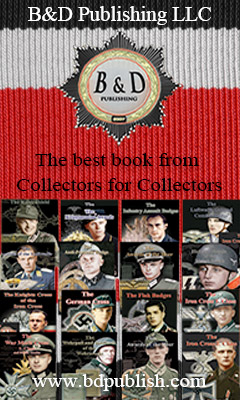RLB Hauptführer Collar Tabs
SKU: 56.GOR.03.02.02.01.007
Estimated market value:

Estimated market value:
Attributes
History
Air raid protection organisations existed during the time of the Weimar Republic in the 1920s. However, in preparation for a coming war, a greater need for a centralised organisation under NSDAP control arose. It was established mere months after the NSDAP took control of Germany. The Reichsluftschutzbund (National Air Raid Protection League) or RLB was founded on April 29, 1933 under the control of Hermann Göring as Minister of Aviation. Naturally, its leader, as well as the nature of the organisation’s tasks, meant that the RLB would always have close ties to the Luftwaffe. All previously founded air raid protection organisations ceased to exist or were forcefully absorbed into the RLB.
The RLB’s function was to train the public on how to prepare for and deal with enemy air raids, and act as a supervisor of civil protection and defense, for both private homes and for places of work. Therefore, the RLB’s focus was split up into what was referred to as Selbstschutz (self-defense) for homes and Erweiterter Selbstschutz (extended self-defense) for places of work. Air raid protection of industry that was deemed essential to the war effort was referred to as Werkluftschutz (Factory Air Raid Protection) or WLS.
The core of the organisation was made up of high-ranking Luftwaffe officers (the RLB leader was always a Luftwaffe General) and a number of full-time salaried RLB members. These professional RLB members made up only a minority of the organisation, since the vast majority of members were, in fact, volunteers. Eventually, a law passed on June 26, 1935 made it a legal duty for almost everybody to receive training by the RLB.
In May of 1937, the Sicherheits- und Hilfsdienst (Security and Assistance Service) or SHD was founded. This was meant as a sister organisation of the RLB made up of professionals rather than amateurs, including firefighters, medical personnel, and specialist troops like public utilities repair service, gas decontamination service, or salvage crews.
At the same time, the Luftschutzwarndienst (Air Raid Warning Service) or LSW was founded. It was intended as an intermediary between the Flugmeldedienst (Flight Message Service) and the air raid protection organisations. The Flugmeldedienst was responsible for spotting enemy aircraft and determining their likely targets, so the population could receive a warning before an attack was carried out.
The SHD was split in the spring of 1942, with the Luftwaffe taking control of its mobile (motorised) units, and the Police taking control of its static units under the name of Luftschutzpolizei (Air Raid Defense Police).
The water-related units were formed into a new organisation, the Wasserstraßenluftschutz (Waterways Air Defense) or WSL. This organisation was entirely separate from and not affiliated with the Wasserschutzpolizei, the Water Protection Police. The WSL’s creation was officially announced on June 1, 1942.
Collar tabs were used to indicate rank in the RLB. They were worn on both collars as mirrored images of each other. The base colour is lilac. Ranks are indicated by silver-coloured Tresse (braid) in the shape of an “L” and metal pips in the form of three-sided stars for lower ranks. Officer collar tabs are piped in silver (gold for the highest rank) and feature the same pips, as well as open laurel wreaths.
All RLB ranks featured the word “Luftschutz” (air raid protection), sometimes as a prefix. It was often abbreviated to “LS”. The rank structure was first introduced on March 7, 1934, but subsequently changed twice, on November 30, 1935, and in October of 1938.
Officer ranks were:
Präsident (Kommandeur between March 7, 1934 and November 29, 1935)
Generalhauptführer (Vizepräsident between November 30, 1935 and October of 1938 and Vizekommandeur between March 7, 1934 and November 29, 1935)
Generalführer (introduced in October of 1938)
Oberstführer (introduced in October of 1938)
Oberststabsführer (introduced in October of 1938)
Stabsführer (Gruppenführer between November 30, 1935 and October of 1938, and Kommandant between March 7, 1934 and November 29, 1935)
Hauptführer (Kapitän between March 7, 1934 and November 29, 1935)
Oberführer (Obertruppführer between March 7, 1934 and November 29, 1935)
Führer (Truppführer between March 7, 1934 and November 29, 1935)
Lower ranks were:
Obertruppmeister
Truppmeister
Untertruppmeister
Obertruppwart
Truppwart
Untertruppwart
Obertruppmann
Truppmann
The ranks of Untertruppwart and Untertruppmeister, introduced on March 7, 1934, in practice were never used.
The 1st pattern collar tabs were introduced on March 7, 1934, the 2nd pattern was introduced on November 30, 1935, and the 3rd pattern was introduced in October of 1938. The highest rank only has a 4th pattern, which was introduced in 1940.
The 1st pattern Präsident collar tabs are lilac with silver-coloured piping, featuring a large silver-coloured wreath with two silver-coloured pips. The 2nd pattern tabs are white with gold-coloured piping, a large gold-coloured wreath, and two gold-coloured pips. The 3rd pattern tabs are smaller than the tabs of the previous patterns. They are white with gold-coloured piping, a gold-coloured border or laurel leaves (with a small opening at the top), and one gold-coloured pip. The 4th pattern is almost identical to the 3rd pattern, except that it features three pips.
The 1st pattern Generalhauptführer collar tabs are lilac with silver-coloured piping, featuring a large silver-coloured wreath with one silver-coloured pip. The 2nd pattern tabs are white with gold-coloured piping, a large gold-coloured wreath, and one gold-coloured pip. There was no change with the introduction of the 3rd pattern.
Since the rank of Generalführer was only introduced in 1938, there is only one pattern, the 3rd pattern. The collar tabs are lilac with gold-coloured piping and a large gold-coloured wreath.
The ranks of Oberstführer and Oberststabsführer were also only introduced in 1938. The collar tabs are lilac with silver-coloured piping and a large silver-coloured wreath, with two silver-coloured pips for Oberstführer and one pip for Oberststabsführer.
The collar tabs for the Stabsführer are the same, only without any pips. This rank went through all three collar tab stages, but these particular collar tabs were never changed.
The ranks of Hauptführer, Oberführer, and Führer also went through all three collar tab stages, but were never changed. They are lilac, with silver-coloured piping and a small silver-coloured wreath, with two silver-coloured pips for Hauptführer, one for Oberführer, and no pips for Führer.
The following tabs are for the lower ranks. All are lilac and don’t feature piping. Tresse and pips are silver-coloured.
The collar tabs for the ranks of Obertruppmeister and Truppmeister also never changed. Obertruppmeister wore collar tabs with Tresse and three pips, while Truppmeister only wore two pips.
Untertruppmeister wore the same collar tabs with only one pip. This rank was discontinued in 1935.
The 1st pattern collar tabs for an Obertruppwart featured just the Tresse and no pips. The 2nd pattern tabs feature the Tresse and one pip. In that, they are identical to the, by then discontinued, Untertruppmeister tabs.
The 1st pattern collar tabs for a Truppwart featured three pips. The 2nd pattern tabs feature Tresse and no pips. In that, they are identical to the 1st pattern Obertruppwart collar tabs.
The Untertruppwart collar tabs feature two pips. This rank was discontinued in 1935.
The Obertruppmann collar tabs feature one pip. The Truppmann collar tabs are blank. The collar tabs for these ranks never changed.

Versions
N/A


Comments
Sign in to comment and reply.


Scroll Top